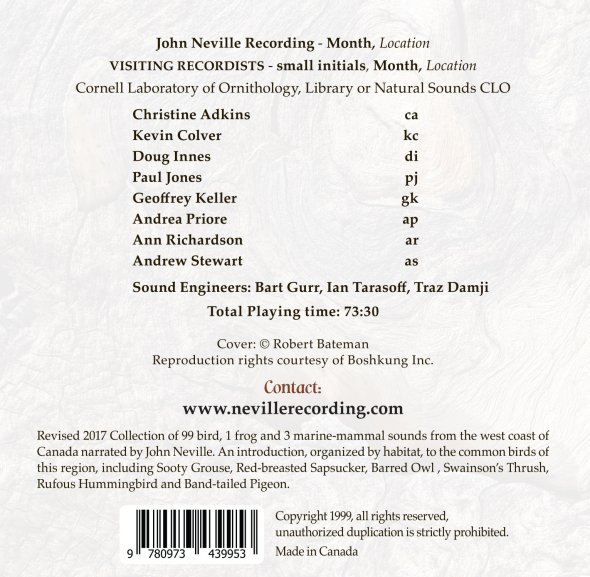Bird Songs of Canada's West Coast Revised 2017 Collection of 99 bird, 1 frog and 3 marine-mammal sounds from the west coast of Canada narrated by John Neville. An introduction, organized by habitat, to the common birds of this region, including Sooty Grouse, Red-breasted Sapsucker, Barred Owl, Swainson's Thrush, Rufous Hummingbird and Band-tailed Pigeon. As you undoubtedly know, the overwhelming majority of commercial bird recordings are simply a list of names followed by one or more vocalizations, leaving it to the user to figure out how to distinguish similar sounding species. Although an excellent set of basic introductional recordings was made in the late 1980s and the early 1990s(the Birding by Ear series), I am unaware of other similar products. Also, many species have regional "accents" which can vary significantly, yet rarely are the locations of recordings noted. Bird Songs of Canada's West Coast, on the other hand, provides basic descriptions and identifies where each recording was made. For example, the first species is a Song Sparrow, from Pender Island, doing its classic maids, maids, maids, put on the kettle-ettle-ettle song. This is followed by a different individual, from Salt Spring Island, imitating the trill of a Spotted Towhee(heard in the background). While more could have been done, such as distinguishing the Song Sparrow's song from that of the Bewick's Wren (presented five tracks later), or suggesting how to separate trills of the sparrow and the towhee, the approach used is distinctly better than the typical name/vocalization format. Also, the transliterations and descriptions used in Bird Songs of Canada's West Coast include some I had not previously encountered. For example: hey sweetie for the Black-capped Chickadee song (a three-note version) and a comparison between the trill of a Orange-crowned Warbler and the sound made running your finger along the teeth of a comb. My initial reaction was that these descriptions were not helpful. However, as I listened longer, I came to appreciate that these new (for me) "handles" did reflect the subject vocalizations. Thus, Neville offers additional devices to help remember these songs and calls. Background sounds are included which, generally, provide additional context. (For some interesting thoughts on the significance of audio context, see Bernie Krause's discussion of "biophonics" in his 1998 book Into a Wild Sanctuary.) However, the surf accompanying the Chestnut-backed Chickadees is much too loud. On the other hand, Neville's description of how he stalked a Sandhill Crane for 15 minutes only to have it then approach him for a handout breaks the monotony typical in name/song products, and is reminiscent of BBC's rather entertaining Bill Oddie videos. Bird Songs of Canada's West Coast also adds context by offering House Sparrow and Double-crested Cormorant vocalizations from a mixed colony, a discussion about two Barred Owls conversing with each other, a male Pelagic Cormorant's call as he returns to feed his mate, and the change in the vocalizations of a colony of Glaucous-winged Gulls as a Bald Eagle flies by. Likewise, the calls of Bushtits are explained as helping to keep the flock together, while an example is given of a European Starling imitating a Bald Eagle to intimidate other birds. On the other hand, I question some of Neville's assertions. he recommends a one-to-one sugar-to-water ratio for hummingbird feeders, contrary to the generally accepted one-to-four ratio. he also states that in medieval times the Common Nighthawk was thought to drink blood. But medieval times is a term related to European history, there are no nighthawks in Europe, and the single widespread European member of the family was thought to suckle goats, not drink blood. A more unfortunate situation involves the calls of two individuals identified as Hairy Woodpeckers, one of which is a Belted Kingfisher. Regardless of these errors, and even though only a relatively small number of species are covered, Bird Songs of Canada's West Coast is better than most commercially available recordings. Many of these, including most instuctional CD-ROMs, simply name the species followed by one or more vocalizations. This one identifies where the recordings were made and provides a degree of context. Michael R Hannisian 
|